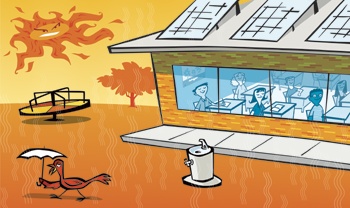School districts in Texas got a big assignment in 2007 from state legislators. Alongside state agencies and institutions of higher learning, they were charged with reducing their respective district’s annual electricity consumption by 5 percent each year through 2013.
The new law, sponsored by now-Speaker of the House Joe Straus, calls for school districts to use energy-efficient lightbulbs, implement energy-efficiency programs and apply available funds to install solar panels where feasible.
Several schools in co-op service areas have already signed on to solar projects with the State Energy Conservation Office’s (SECO) “Texas Solar for Schools” program, initiated in 2001. Participating schools receive a 1- to 3-kilowatt solar panel system, a Web-based monitoring system and additional hands-on learning tools to support education and staff training. During installation of the solar panels, students are encouraged to lend a hand and find out for themselves what makes the system work.
After the system is installed, SECO provides teacher training with lesson plans corresponding to renewable energy fact sheets and ideas for student projects. In all, 53 elementary, middle and high schools in Texas are saving and producing energy through SECO’s Texas Solar for Schools. Many are served by electric cooperatives.
Marion Middle School, served by Guadalupe Valley Electric Cooperative (GVEC), has been reaping the rewards of a solar panel system that GVEC helped finance and install in 2005.
Marion Middle School Principal Daryl Wendel said, “I think the idea of working in a more green direction in schools is a terrific concept, one we can model for our students.”
The Web-based monitoring system tracks data on the performance of the school’s photovoltaic system as well as those of schools across the nation.
The students studied cumulative data from May 2005 to November 2008 that showed that Marion Middle School had produced 4,168 kilowatt-hours of electrical energy. Students learned that’s enough electricity to power 320,615 hours of light from a compact fluorescent lightbulb, offset 5,804 pounds of carbon dioxide emissions or generate enough electricity to talk nonstop on a mobile phone for 252,605,939 minutes—more than 480 years!
Renewable energy fact sheets and lesson plans are available to all Texas schools from the Infinite Power of Texas website, www.infinitepower.org.
———————-
Carol Moczygemba is executive editor of Texas Co-op Power.


